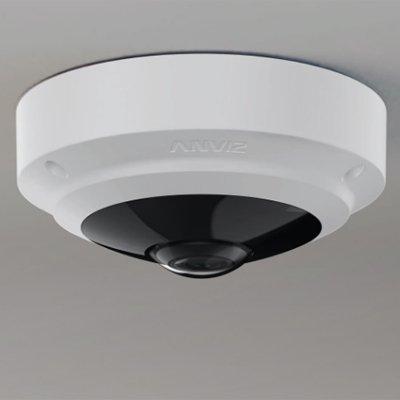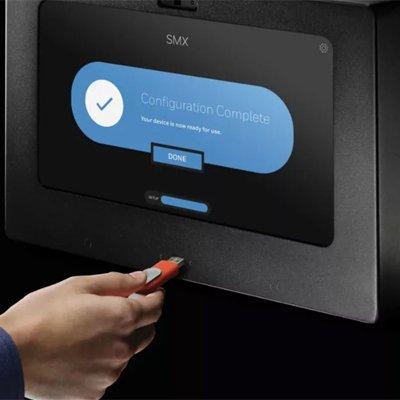D-Tec's MD, Ian Moore, explains the importance of smoke detection systems in the early detection of tunnel fires.
Fire in the context of tunnels has been brought into sharp relief in recent years, as a result of a number of high profile tragedies. Most notably the Mont Blanc Tunnel in 1999, which claimed the lives of 39 people. As a result, there has been increasing interest in the application of CCTV cameras in conjunction with video analytics technology, specifically Video Smoke Detection (VSD), to provide vital early warning of accidents.
Effective detection - heat or smoke?
When it comes to fire prevention and safety, road, rail and service tunnels present an extremely testing proposition because of their small cross sectional area. As some modern tunnels can stretch many miles in length, access is more problematic than in many other scenarios. The higher heat release rate within these tunnels is also associated with the fires that develop within this environment.
Experience suggests that it is smoke and not heat that is needed to obtain vital advance notice of imminent danger. Sadly in the past, many people have perished before more commonly deployed heat detection systems have been initiated due to smoke inhalation and the smoke in the tunnels has impaired driver's vision causing accidents.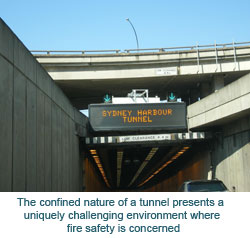
Historically smoke detection in road tunnels was difficult due to the dirty environment that created many false alarms as a result of vehicle exhaust fumes. This factor was compounded by the near impossible task of maintaining any device in working order within acceptable limits. Thankfully, VSD, due to its design and complex algorithms, has the potential to overcome these problems.
Video Smoke Detection (VSD)
Looking in more detail at VSD, this approach works by utilizing standard CCTV images in realtime - from any number of cameras simultaneously - that are then analysed by specialized image processing software. It seeks out the particular pattern that smoke produces by applying extensive detection and known false alarm algorithms. By programming the software to look for anticipated motion patterns of smoke over a specified area within a camera image, and analysing pixel changes, VSD has the potential to deliver an exceptionally fast response - typically in seconds.
Crucially, once smoke has been detected the system can alert the operator as well as deliver a visual representation of the smoke on the system's monitor. Whether the camera is situated 10 metres or 100 metres from a risk area, VSD has the capacity to detect smoke, providing an early warning that would be impossible with conventional detection.
In addition, as the location of smoke can be readily identified by using cameras at multiple points, the VSD system can supply valuable management information to those responsible for fire safety. It allows passengers or commuters to be directed safely away from any incident whilst avoiding the most dangerous areas - this situational awareness is particularly beneficial in tunnels with a gradient where smoke as it rises will tend to gather more on a particular side of a fire.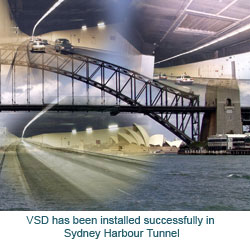
It is important to stress that VSD is distinct from other camera-based detection systems that are in reality motion detectors or obscuration-change detectors. These are unable to differentiate between smoke and other sources of movement and so are liable to generate a high level of false alarms. This is not the case with VSD whose sophisticated algorithms allow it, for example, to readily distinguish between smoke and other similar phenomena, which can prove problematic for other solutions.
Application of VSD at Sydney Harbour Road Tunnel
When it comes to the practical application of CCTV camera-based Video Smoke Detection (VSD), Sydney Harbour Road Tunnel offers an impressive reference point in terms of the capability of this FM-approved technology, to provide a rapid response to potential fires.
In this case, VSD was retrofitted to 80 of the tunnel's CCTV cameras - 40 in each tube - offering a vital early warning of incidents in the tunnel which carries nearly 90,000 vehicles a day.
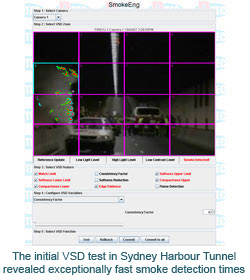 A series of controlled vehicle fires were created to test the tunnel's exhaust system's ability to remove smoke, the activation of the point detectors, and the capability of the deluge system to suppress a fire. At this stage the Sydney Harbour Road Tunnel management invited D-Tec and our Australian agent Chubb Fire Safety to take part in these tests and trial the Video Smoke Detection system (VSD).
A series of controlled vehicle fires were created to test the tunnel's exhaust system's ability to remove smoke, the activation of the point detectors, and the capability of the deluge system to suppress a fire. At this stage the Sydney Harbour Road Tunnel management invited D-Tec and our Australian agent Chubb Fire Safety to take part in these tests and trial the Video Smoke Detection system (VSD).
During the live burning of the vehicles, temperatures at the fire site reached in excess of 500°C. The operation of the deluge system was delayed in order to allow the fire to develop and for a large volume of smoke to spread along the tunnel. The live images of the fire were screened through the VSD system and crucially, the first alarm was generated in 14 seconds of visible smoke and prior to any visible flames, a further 30 alarms were generated throughout the remainder of the test burn. The key point here is that at no point during the tests did any of the older automated systems within the tunnel generate an alarm.
A networked future
Looking ahead for future tunnel projects, whether it be the exciting installations protecting multiple road tunnels in Italy or service tunnels in Dubai and Sydney, from our perspective at D-Tec we see the trend in VSD moving towards systems which come with a networked capability so no solution is limited to being monitored locally on site.
 Now with the latest IP enabled systems, such as our own FireVu, there is the potential to offer 24-hour remote monitoring. This offers a fast response to incidents, with alarm and associated video images distributed to an unlimited number of locations for review by using a network's TCP/IP (Transmission Control Protocol/Internet Protocol) as the communications backbone. A key advantage, from a tunnel operator's perspective, is that one control centre can potentially be used to monitor a number of FireVu VSD tunnel installations.
Now with the latest IP enabled systems, such as our own FireVu, there is the potential to offer 24-hour remote monitoring. This offers a fast response to incidents, with alarm and associated video images distributed to an unlimited number of locations for review by using a network's TCP/IP (Transmission Control Protocol/Internet Protocol) as the communications backbone. A key advantage, from a tunnel operator's perspective, is that one control centre can potentially be used to monitor a number of FireVu VSD tunnel installations.















